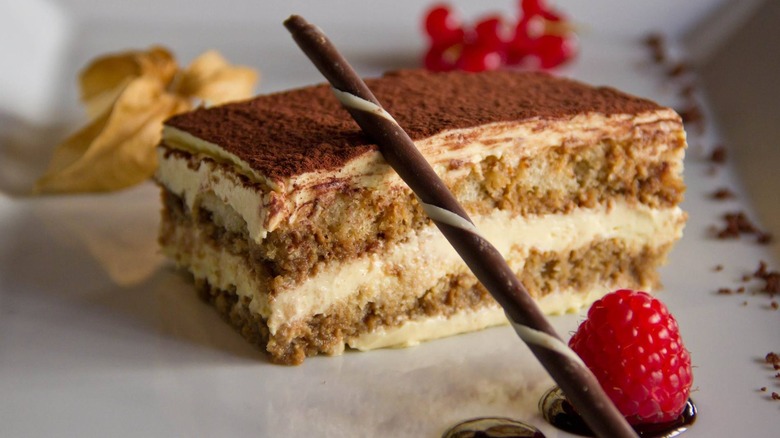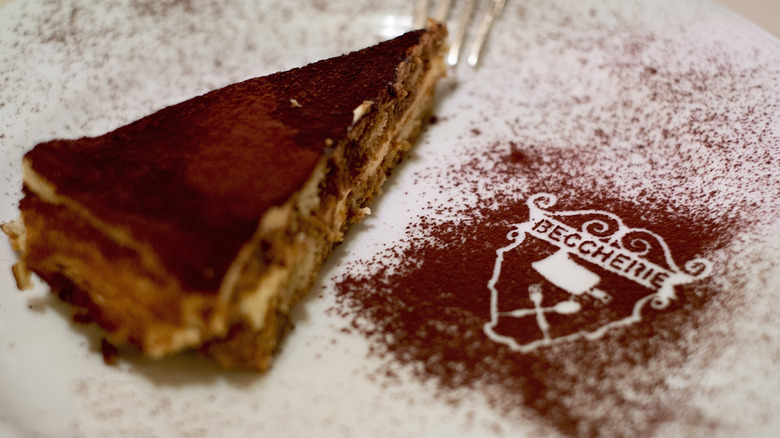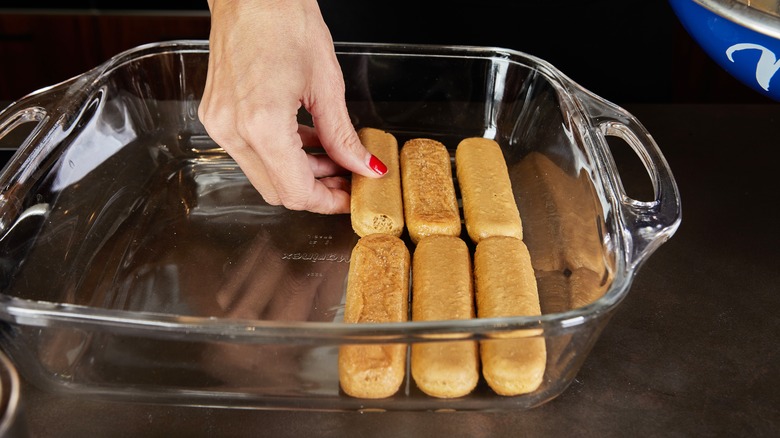Tiramisu Actually Started Off As A Happy Accident
The elegance of a perfectly made tiramisu can impress even the most implacable food critics. Creamy mascarpone cheese harmonizes the chocolate and subtle hints of espresso, and the spongy ladyfingers contrast the creamy texture of the mascarpone filling in this stylish, layered Italian dessert. It is perfection on a plate, and it would be a mistake in any traditional Italian restaurant to order a customized version. The makeup is so intricate that it would surprise many to know that if an accident had not occurred in the kitchen one day, this dish might never have come to be.
Roberto "Loli" Linguanotto — the father of the tiramisu — developed the confection while working as a pastry chef at Le Beccherie in Treviso, Italy. One day, he mistakenly poured mascarpone into a bowl of sugar and eggs, and rather than throw it out, ran with the inspired combo. Collaborating with the restaurant owner's wife, Alba Campeol, Linguanotto worked to perfect the dish.
The dessert debuted on the Le Beccherie menu in 1972 once the recipe had been optimized. Linguanotto witnessed his creation receive widespread acclaim not long after and was surely delighted to see it bring joy to so many faces until his recent passing at the age of 81. A heartwarming sendoff was posted to Le Beccherie's Facebook page on July 28, in English reading, "We join the mourning for the passing of Roberto "Loli" Linguanotto, who marked the history of Beccherie and the most beloved dessert in the world. His memory lives on in our restaurant! Thank you Loli."
Linguanotto's tiramisu spread like wildfire
Despite being born of a simple mistake, Linguanotto's sweet treat was destined to be a classic. Today, tiramisu – meaning "pick me up" – is one of those words you should know when dining at an Italian restaurant. Originally, the dessert was more custard-heavy and circular, as opposed to the square version offered in restaurants today. It quickly became a standard dessert in eateries throughout Italy, and it wasn't long until it made its way overseas. By the early 1980s, tiramisu was a predominant choice in bakeries and Italian restaurants all around New York City.
As New Yorkers gushed over the newest delicacy to hit the scene, it started to be discovered by other areas of the country. The creamy, chocolatey taste was enticing to people outside the Big Apple, and many establishments across America began attempting to mimic the dish in their own kitchens. As the "Tuscan Trifle" continued to gain notoriety in culinary circles, it became a staple menu item for any Italian restaurant in the U.S., often prepared table side.
Numerous adaptations were attempted as folks tried to copycat the dish until it became the dessert people know and love today. Tiramisu was soon recognized globally as peak culinary mastery. It's still a cherished staple in many restaurants worldwide, but thankfully, you don't need to be an expert chef to recreate the confection at home.
How is a tiramisu constructed?
A perfect tiramisu can seem intimidating to make, but this no-bake dessert isn't as challenging as it looks. Recipes vary, but the key components of eggs, sugar, mascarpone, ladyfingers, espresso, cocoa, and alcohol such as Marsala wine, Amaretto liqueur, brandy, or rum (rum and chocolate are a pairing that's meant to be) are generally present. Start by combining the alcohol, cocoa, and hot espresso in a bowl and set them aside.
Next, set up a double boiler and add your eggs and sugar into the bowl, stirring constantly until the mixture reaches 160 degrees Fahrenheit. Using a stand mixer, take the egg mixture and whip it on high until it begins to take on a lighter color and quadruples in size. Turn the mixer to a lower speed and add your mascarpone one hefty scoop at a time. At this point, you're ready for assembly.
Soak the ladyfingers in the espresso blend for a couple of seconds each and lay them across the bottom of a baking dish. Top with half the mascarpone composite, dust with cocoa powder, and add another layer of booze-soaked ladyfingers. Place the last of your mascarpone blend on top and dust again with more cocoa powder. Cover the dessert and let it set in the refrigerator for at least an hour. You now have a modern version of Linguanotto's classic tiramisu — and who knows, precariously lay some ingredients around and you too might pull a happy accident.
Static Media owns and operates Foodie and Food Republic.


